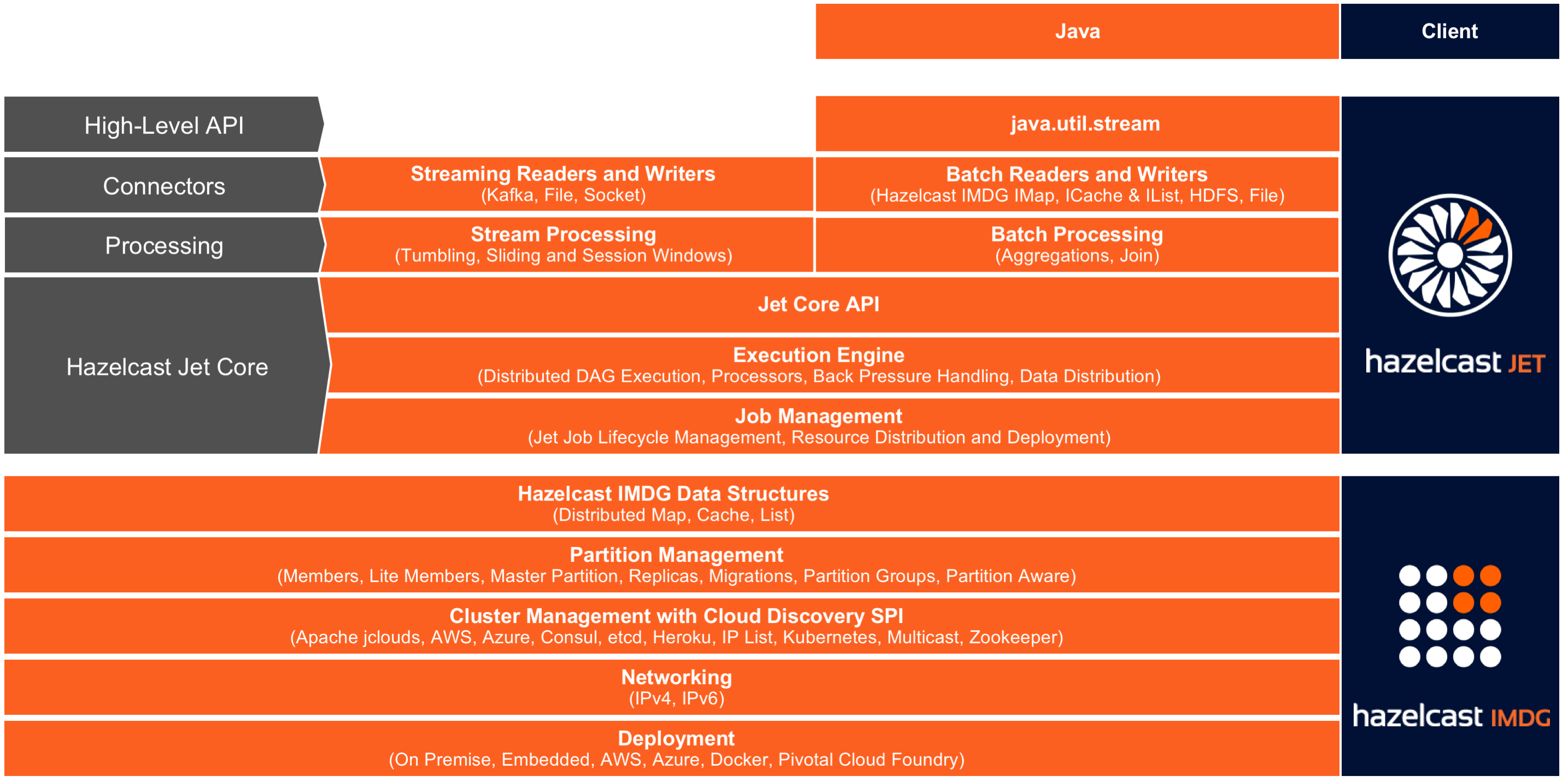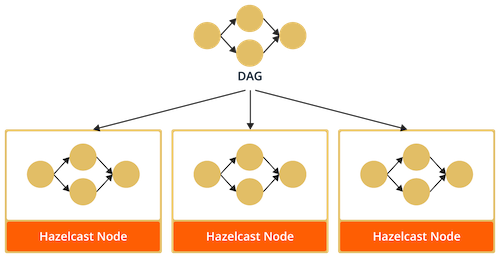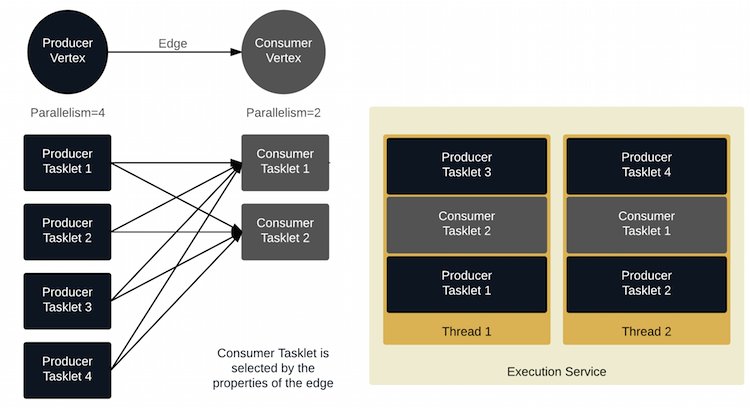Hazelcast Jet is a distributed data processing engine, built for high-performance batch and stream processing. It reuses some features and services of Hazelcast In-Memory Data Grid (IMDG), but is otherwise a separate product with features not available in the IMDG.
Jet also enriches the IMDG data structures such as IMap and IList
with a distributed implementation of
java.util.stream.
With Hazelcast’s IMDG providing storage functionality, Hazelcast Jet performs parallel execution to enable data-intensive applications to operate in near real-time. Using directed acyclic graphs (DAG) to model relationships between individual steps in the data processing pipeline, Hazelcast Jet can execute both batch and stream-based data processing applications. Jet handles the parallel execution using the green thread approach to optimize the utilization of the computing resources.
Breakthrough application speed is achieved by keeping both the computation and data storage in memory. The embedded Hazelcast IMDG provides elastic in-memory storage and is a great tool for storing the results of a computation or as a cache for datasets to be used during the computation. Extremely low end-to-end latencies can be achieved this way.
It is extremely simple to use -- in particular, Jet can be fully embedded for OEMs and for Microservices – making it is easier for manufacturers to build and maintain next generation systems. Also, Jet uses Hazelcast discovery for finding the members in the cluster, which can be used in both on-premise and cloud environments.
High-level overview of Jet's Architecture

The Data Processing Model
Hazelcast Jet provides high performance in-memory data processing by
modeling the computation as a Directed Acyclic Graph (DAG) where
vertices represent computation and edges represent data connections. A
vertex receives data from its inbound edges, performs a step in the
computation, and emits data to its outbound edges. A single vertex's
computation work is performed in parallel by many instances of the
Processor type around the cluster.
One of the major reasons to divide the full computation task into several vertices is data partitioning: the ability to split the data stream traveling over an edge into slices which can be processed independently of each other. To make this work, a function must be defined which computes the partitioning key for each item and makes all related items map to the same key. The computation engine can then route all such items to the same processor instance. This makes it easy to parallelize the computation: each processor will have the full picture for its slice of the entire stream.
Edges determine how the data is routed from individual source processors to individual destination processors. Different edge properties offer precise control over the flow of data.
Clustering and Discovery
Hazelcast Jet typically runs on several machines that form a cluster but it may also run on a single JVM for testing purposes. There are several ways to configure the members for discovery, explained in detail in the Hazelcast IMDG Reference Manual.
Members and Clients
A Hazelcast Jet instance is a unit where the processing takes place. There can be multiple instances per JVM, however this only makes sense for testing. An instance becomes a member of a cluster: it can join and leave clusters multiple times during its lifetime. Any instance can be used to access a cluster, giving an appearance that the entire cluster is available locally.
On the other hand, a client instance is just an accessor to a cluster and no processing takes place in it.
Relationship with Hazelcast IMDG
Hazelcast Jet leans on Hazelcast IMDG for cluster formation and maintenance, data partitioning, and networking. For more information on Hazelcast IMDG, see the latest Hazelcast Reference Manual.
As Jet is built on top of the Hazelcast platform, there is a tight integration between Jet and IMDG. A Jet job is implemented as a Hazelcast IMDG proxy, similar to the other services and data structures in Hazelcast. The Hazelcast Operations are used for different actions that can be performed on a job. Jet can also be used with the Hazelcast Client, which uses the Hazelcast Open Binary Protocol to communicate different actions to the server instance.
Reading from and Writing to Hazelcast Distributed Data Structures
Jet embeds Hazelcast IMDG. Therefore, Jet can use Hazelcast IMDG maps,
caches and lists on the embedded cluster as sources and sinks of data
and make use of data locality. A Hazelcast IMap or ICache is
distributed by partitions across the cluster and Jet members are able to
efficiently read from the Map or Cache by having each member read just
its local partitions. Since the whole IList is stored on a single
partition, all the data will be read on the single member that owns that
partition. When using a map, cache or list as a Sink, it is not possible
to directly make use of data locality because the emitted key-value pair
may belong to a non-local partition. In this case the pair must be
transmitted over the network to the member which owns that particular
partition.
Jet can also use any remote Hazelcast IMDG instance via Hazelcast IMDG connector.
Fault Detection
In its current version, Hazelcast Jet can only detect a failure in one of the cluster members that was running the computation, and abort the job. A feature planned for the future is fault tolerance: the ability to go back to a saved snapshot of the computation state and resume the computation without the failed member.
Elasticity
Hazelcast Jet supports the scenario where a new member joins the cluster while a job is running. Currently the ongoing job will not be re-planned to start using the member, though; this is on the roadmap for a future version. The new member can also leave the cluster while the job is running and this won't affect its progress.
One caveat is the special kind of member allowed by the Hazelcast IMDG: a lite member. These members don't get any partitions assigned to them and will malfunction when attempting to run a DAG with partitioned edges. Lite members should not be allowed to join a Jet cluster.
The DAG
At the core of Jet is the distributed computation engine based on the paradigm of a directed acyclic graph (DAG):

Vertex
The vertex represents a stage in the pipeline of the distributed computation job. The three main categories of vertex are the source, the sink, and the computational vertex. Jet doesn't make a formal distinction between these; for example, any vertex lacking inbound edges acts as a source. Internally it is implemented in terms of the same API as a sink or a computational vertex.
A source can be distributed, which means that on each member of
the Jet cluster a different slice of the full data set will be read.
Similarly, a sink can also be distributed so each member can write a
slice of the result data to its local storage. Data partitioning is
used to route each slice to its target member. Examples of distributed
sources supported by Jet are HDFS files and Hazelcast's IMap, ICache
and IList.
The executable code of a vertex is implemented in a subtype of the
Processor interface. To run a job, Jet creates several instances of
this type on each cluster member. It routes a part of the complete data
stream to each processor and on the output side it collects the partial
data streams from each processor, reshuffles the data as configured on
the edge, and routes to downstream processors.
Edge
The edge transfers data from one vertex to the next and contains the logic that decides which target processor an item should be routed to. This could be guided by the partitioning logic, or could be one of the other choices like broadcast or pooled unicast. An edge may be configured to keep the data within a member, routing only to local processors. This allows us to design DAGs which optimally balance network and memory usage.
Running a Jet job
After a Job is created, Jet replicates the DAG to the whole Jet
cluster and executes it in parallel on each member.

Execution is done on a user-configurable number of threads which use work stealing to balance the amount of work being done on each thread. Each worker thread has a list of tasklets it is in charge of and as tasklets complete at different rates, the remaining ones are moved between workers to keep the load balanced.
Each instance of a Processor is wrapped in one tasklet which is
repeatedly executed until it reports it is done. A vertex with a
parallelism of 8 running on 4 members would have a total of 32 tasklets
running at the same time. Each member will have the same number of
tasklets running.

When a request to execute a Job is made, the corresponding DAG and additional resources are deployed to the Jet cluster. An execution plan for the DAG is built on each member, which creates the associated tasklets for each Vertex and connects them to their inputs and outputs.
Jet uses Single Producer/Single Consumer ringbuffers to transfer the data between processors on the same member. They are data-type agnostic, so any data type can be used to transfer the data between vertices.
Ringbuffers, being bounded queues, introduce natural backpressure into the system; if a consumer’s ringbuffer is full, the producer will have to back off until it can enqueue the next item. When data is sent to another member over the network, there is no natural backpressure, so Jet uses explicit signaling in the form of adaptive receive windows.
